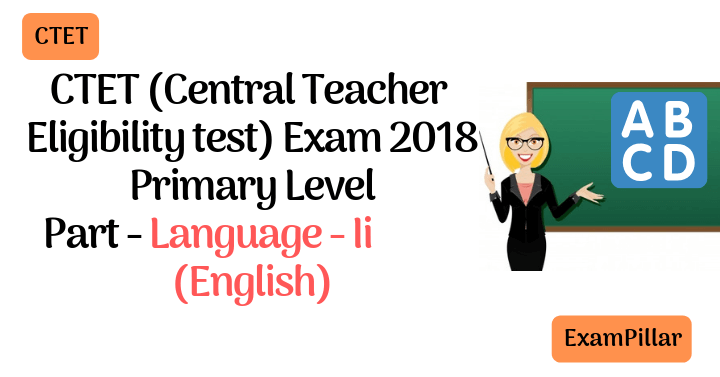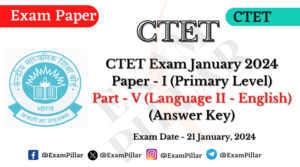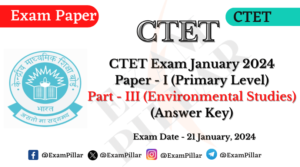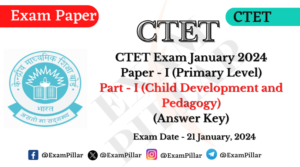CBSE conducted the CTET (Central Teacher Eligibility Test) Exam Paper held on 09th Dec 2018 Evening Shift. Here The CTET Solved Question Paper I (Class I to V) Answer-key.
CTET (Central Teachers Eligibility Test) Paper First : Primary Level (Class 1 to Class 5).
परीक्षा (Exam) : CTET Paper I (Class I to V)
भाग (Part) : Language – II English
परीक्षा आयोजक (Organized) : CBSE
कुल प्रश्न (Number of Question) : 30
Paper Set – I
परीक्षा तिथि (Exam Date) – 09th Dec 2018
Read Also …
- CTET 2018 Paper -I – Part – I – बाल विकास और शिक्षा-शास्त्र (Child Development and Pedagogy)
- CTET 2018 Paper -I – Part – II – गणित (Mathematics)
- CTET 2018 Paper -I – Part – III – पर्यावरण अध्ययन (Environmental Studies)
- CTET 2018 Paper -I – Part – IV – Language – I (English)
- CTET 2018 Paper -I – Part – IV – Language – I हिंदी (Hindi)
- CTET 2018 Paper -I – Part – V – Language – II हिंदी (Hindi)
CTET Exam 2018 Paper – 1 (Primary Level)
Language – II (English)
Directions : Read the passage given below and answer the questions that follow (Q. Nos. 1 to 9) by selecting the correct/most appropriate options.
Man who is believed to have evolved from apes, is a curious mixture of varied motives. He is not only the subject of needs but is also their creator. He not only seeks to satisfy his needs but also caters to his desire for beauty and grace. He is eager to satisfy his passion for more and more knowledge. Although in a general way, the maxim ‘necessity is the mother of invention’ is true, it is by no means the whole truth. Man is something much greater than an intelligent being using his intellect to make newer inventions from time to time. He has within him a spirit which is ever exhorting him to cut down his needs and learn to be happy with what he has. The real purpose underlying this maxim lies in its utility in the worldly sense. It tells us to be up and doing, not to be passive in our attitude to life. It asks us not to remain slaves of old habits and ways of life. We must face the new situations with a creative mind. Every new difficulty, every new problem, which confronts us in life, can be tackled successfully with the spirit of inventiveness.
1. Which one of the following is not the whole truth according to the passage?
(1) Man has a desire for beauty and grace.
(2) Necessity is the mother of invention.
(3) Man desires to cut down his needs and wants.
(4) Man learns to be happy with what he has.
Show Answer/Hide
2. What does the maxim mentioned in the passage teach us?
(1) To be worldly in the strict sense of the term
(2) To be slave of our needs and wants
(3) To endeavour constantly to create new passions and desires
(4) To be active in life and do something to help mankind
Show Answer/Hide
3. What does the spirit within man tell him to do?
(1) To be a mixture of varied motives
(2) To evaluate the situations intelligently
(3) To cut down his desires and passions
(4) To acquire more and more wealth and comforts
Show Answer/Hide
4. Which of the following statements is/are true in the context of the passage?
I. Man should be passive in his attitude to life.
II. Spirit of inventiveness may not stand in good stead in solving every new problem.
III. Man has a passion for more and more knowledge.
(1) Only I
(2) Only I and II
(3) Only III
(4) Only II and III
Show Answer/Hide
5. Which one of the following is similar in meaning to the word ‘maxim’ as used in the passage?
(1) Dfinciple
(2) Direction
(3) Value
(4) Observation
Show Answer/Hide
6. Which one of the following is not the characteristic of man as per the passage?
(1) Man has many needs and motives.
(2) Man creates many needs for himself.
(3) Man seeks to satisfy his needs.
(4) Man desires to have more and more comforts and money.
Show Answer/Hide
7. Which one of the following statements is not true as per the passage?
(1) Spirit of inventiveness will stand in good stead.
(2) Man is the subject of various wants.
(3) Man creates new needs because they are sometimes good beautiful.
(4) Man’s inner spirit tells him to be on the look out for newer and higher wants.
Show Answer/Hide
8. Choose the word which is opposite in meaning to the word ‘seeks’ are used in the passage.
(1) Deplores
(2) Avoids
(3) Vanishes
(4) Approaches
Show Answer/Hide
9. Which one of the following is similar in meaning to the word ‘exhorting’ as used in the passage?
(1) Urging
(2) Supporting
(3) Demanding
(4) Clarifying
Show Answer/Hide
Directions : Read the passage given below and answer the questions that follow (Q. Nos. 10 to 15) by selecting the correct/most appropriate options.
Did you know that there is a fiber that is as flexible and lightweight as nylon yet five times stronger than steel? Did you know that this fabric is resistant to temperatures higher than 500 degrees Fahrenheit? Did you know that a woman invented this fiber? This miraculous fabric is called Kevlar and it is used to make everything from body armor to musical instruments.
The year was 1964. There were gasoline shortages due to conflict in the Middle East. A Polish American chemist named Stephanie Louise Kowlek was working for DuPont, an American Chemical Company. She and her group were trying to make a lightweight, yet durable fiber to be used in tires. Lighter tires would allow vehicles to get better gas mileage, but the tires had to be strong enough to resist the wear and tear of the road. They had been working on the problem for some time and had little success, until Kwolek had a breakthrough. Kwolek and her group were synthesizing or creating fibers to test. During one of the steps in the process, Kwolek created a milky white solution by mixing two chemicals that were often used in the process. This solution was usually thrown away, but Kwolek convinced one of the technicians to help her test it. They were amazed to discover that the fabric that Kwolek had created was not only more durable than nylon, it was more durable than steel.
Kwolek had invented Kevlar. Kevlar is a remarkable fabric known for its strength and durability. Since its invention it has found its way into a wide variety of products. Kevlar is used in sporting equipment like bike tires, bowstrings, and tennis racquets. It is used in musical instruments like drum heads, reeds, and speaker cones. And it is used in protective gear like motorcycle safety jackets, gloves, and shoes. However, Kevlar is best known for its ability to stop bullets.
Richard Armellino created the first Kevlar bulletproof vest in 1975. It contained 15 layers of Kevlar, which could stop handgun and shotgun bullets. The vest also had a steel plate over the heart, which made the vest strong enough to stop rifle rounds. Vests like Armellino’s were quickly picked up by police forces and it is estimated that by 1990, half of all police officers in America wore bulletproof vests daily. By 2006 there were over 2,000 documented police vest “saves,” or instances where officers were protected from deadly wounds by wearing bulletproof vests
10. Which of the following is not a product that has been made with Kevlar?
(1) Tennis racquets
(2) Bungee jumping cord
(3) Brake pads
(4) Body armor
Show Answer/Hide
11. For which of the following characteristics is Kevlar known?
(1) Heat resistance
(2) Strength
(3) Durability
(4) All of the above
Show Answer/Hide
12. Which of the following caused the search for a fabric like Kevlar?
(1) A shortage in the gasoline supply
(2) A desire to protect police officers
(3) The need to replace asbestos
(4) The want of better musical instruments
Show Answer/Hide
13. A vest made of 15 layers of Kevlar with no steel plates could stop all but which of the following rounds?
(1) Handgun rounds
(2) Shotgun pellets
(3) Rifle rounds
(4) It could stop all of the above
Show Answer/Hide
14. How much stronger is Kevlar than steel?
(1) Half as
(2) As strong
(3) Five times as strong
(4) 200 times as strong
Show Answer/Hide
15. What product was Kwolek trying to improve when she invented Kevlar?
(1) Tires
(2) Milk
(3) Brake pads
(4) Armor
Show Answer/Hide





30. The founder of structural grammar was..
I think, it is miss print..
Answer (3)
‘Noam Chomsky’
Yes Answer Should be – “Noam Chomsky”
But in The Question Paper the option only ‘Chomsky’
What’s the difference.
2
27. Ctet answerd Cariculam is the implementer of education